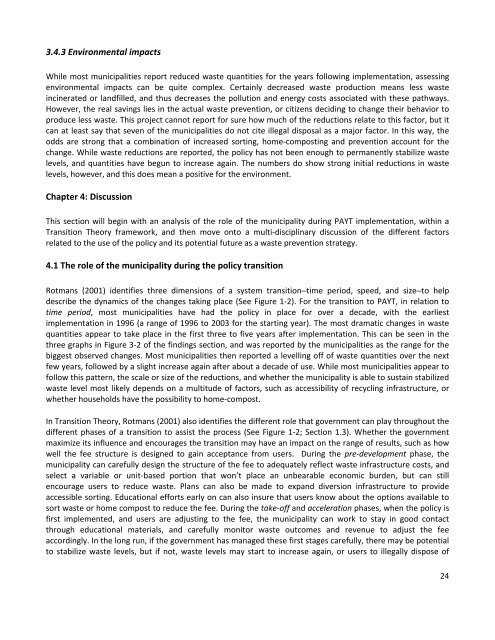Waste prevention and Pay as You Throw, a collective case ... - lumes
Waste prevention and Pay as You Throw, a collective case ... - lumes
Waste prevention and Pay as You Throw, a collective case ... - lumes
You also want an ePaper? Increase the reach of your titles
YUMPU automatically turns print PDFs into web optimized ePapers that Google loves.
3.4.3 Environmental impacts<br />
While most municipalities report reduced w<strong>as</strong>te quantities for the years following implementation, <strong>as</strong>sessing<br />
environmental impacts can be quite complex. Certainly decre<strong>as</strong>ed w<strong>as</strong>te production means less w<strong>as</strong>te<br />
incinerated or l<strong>and</strong>filled, <strong>and</strong> thus decre<strong>as</strong>es the pollution <strong>and</strong> energy costs <strong>as</strong>sociated with these pathways.<br />
However, the real savings lies in the actual w<strong>as</strong>te <strong>prevention</strong>, or citizens deciding to change their behavior to<br />
produce less w<strong>as</strong>te. This project cannot report for sure how much of the reductions relate to this factor, but it<br />
can at le<strong>as</strong>t say that seven of the municipalities do not cite illegal disposal <strong>as</strong> a major factor. In this way, the<br />
odds are strong that a combination of incre<strong>as</strong>ed sorting, home‐composting <strong>and</strong> <strong>prevention</strong> account for the<br />
change. While w<strong>as</strong>te reductions are reported, the policy h<strong>as</strong> not been enough to permanently stabilize w<strong>as</strong>te<br />
levels, <strong>and</strong> quantities have begun to incre<strong>as</strong>e again. The numbers do show strong initial reductions in w<strong>as</strong>te<br />
levels, however, <strong>and</strong> this does mean a positive for the environment.<br />
Chapter 4: Discussion<br />
This section will begin with an analysis of the role of the municipality during PAYT implementation, within a<br />
Transition Theory framework, <strong>and</strong> then move onto a multi‐disciplinary discussion of the different factors<br />
related to the use of the policy <strong>and</strong> its potential future <strong>as</strong> a w<strong>as</strong>te <strong>prevention</strong> strategy.<br />
4.1 The role of the municipality during the policy transition<br />
Rotmans (2001) identifies three dimensions of a system transition–time period, speed, <strong>and</strong> size–to help<br />
describe the dynamics of the changes taking place (See Figure 1‐2). For the transition to PAYT, in relation to<br />
time period, most municipalities have had the policy in place for over a decade, with the earliest<br />
implementation in 1996 (a range of 1996 to 2003 for the starting year). The most dramatic changes in w<strong>as</strong>te<br />
quantities appear to take place in the first three to five years after implementation. This can be seen in the<br />
three graphs in Figure 3‐2 of the findings section, <strong>and</strong> w<strong>as</strong> reported by the municipalities <strong>as</strong> the range for the<br />
biggest observed changes. Most municipalities then reported a levelling off of w<strong>as</strong>te quantities over the next<br />
few years, followed by a slight incre<strong>as</strong>e again after about a decade of use. While most municipalities appear to<br />
follow this pattern, the scale or size of the reductions, <strong>and</strong> whether the municipality is able to sustain stabilized<br />
w<strong>as</strong>te level most likely depends on a multitude of factors, such <strong>as</strong> accessibility of recycling infr<strong>as</strong>tructure, or<br />
whether households have the possibility to home‐compost.<br />
In Transition Theory, Rotmans (2001) also identifies the different role that government can play throughout the<br />
different ph<strong>as</strong>es of a transition to <strong>as</strong>sist the process (See Figure 1‐2; Section 1.3). Whether the government<br />
maximize its influence <strong>and</strong> encourages the transition may have an impact on the range of results, such <strong>as</strong> how<br />
well the fee structure is designed to gain acceptance from users. During the pre‐development ph<strong>as</strong>e, the<br />
municipality can carefully design the structure of the fee to adequately reflect w<strong>as</strong>te infr<strong>as</strong>tructure costs, <strong>and</strong><br />
select a variable or unit‐b<strong>as</strong>ed portion that won’t place an unbearable economic burden, but can still<br />
encourage users to reduce w<strong>as</strong>te. Plans can also be made to exp<strong>and</strong> diversion infr<strong>as</strong>tructure to provide<br />
accessible sorting. Educational efforts early on can also insure that users know about the options available to<br />
sort w<strong>as</strong>te or home compost to reduce the fee. During the take‐off <strong>and</strong> acceleration ph<strong>as</strong>es, when the policy is<br />
first implemented, <strong>and</strong> users are adjusting to the fee, the municipality can work to stay in good contact<br />
through educational materials, <strong>and</strong> carefully monitor w<strong>as</strong>te outcomes <strong>and</strong> revenue to adjust the fee<br />
accordingly. In the long run, if the government h<strong>as</strong> managed these first stages carefully, there may be potential<br />
to stabilize w<strong>as</strong>te levels, but if not, w<strong>as</strong>te levels may start to incre<strong>as</strong>e again, or users to illegally dispose of<br />
24
















